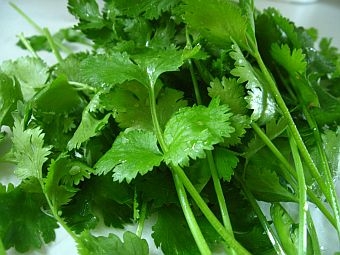 I’m Charlie Nardozzi and this is
I’m Charlie Nardozzi and this is
the Vermont Garden Journal. "O soapy
flavor. Why pollutest thou my food? Thou makest me retch." That’s hardly a ringing endorsement for an
herb, but unfortunately some people feel that way about cilantro. It’s
estimated that 17% of people with European or East Asian ancestry and 14% of
people of African descent say cilantro tastes like soap. While less than 7% of
south Asians, Latin Americans and Middle Easterners feel that way. It’s a
genetic tendency and a 50-50 split in my house. I love cilantro in salads,
soups, shakes and pesto while my wife Wendy goes to great lengths to pick out
cilantro sprigs from any dish she orders.
Cilantro is a fast growing, cool
season herb that if left to flower and fruit produces coriander seeds. The key
with growing cilantro successfully is starting early in spring once the ground
has dried and warmed and sowing seeds or transplanting seedlings into raised
beds. Stress is cilantro’s foe. Too much heat, too little water, too many
weeds, or over crowding cause cilantro to bolt, reducing the number of leaves it produces. So, plant small
batches of cilantro every few weeks into early summer and again starting in
late summer for a continuous harvest. Unless you want to harvest coriander
seeds, pull and compost bolting plants. Try growing slow to bolt varieties such
as ‘Calypso’ and ‘Santo’.
Parsley likes similar growing
conditions as cilantro, but is less finicky. Start parsley seed indoors now or
buy transplants. Parsley makes a great edible ground cover combined with
petunias and other brightly colored flowers. It can withstand frost growing
into early winter in the garden. Plus, it makes one mean green shake! Italian
flat leaved parsley varieties tend to have more flavor and are easier to clean
than curly-leafed varieties.
Now for this week’s tip: Spray fruit trees now with a horticultural
oil before the leaves emerge. This oil will coat overwintering insects and eggs
reducing the amount of pests you have to control.
Next week on The Vermont Garden
Journal I’ll be talking about soil amendments. Until then, I’ll be seeing you
in the garden.
Resources:
Parsley
Cilantro